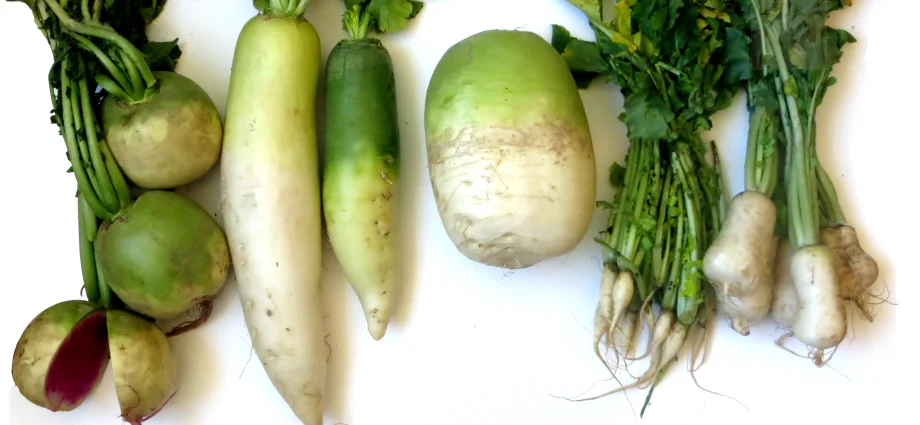Radish is one of the most common root crops due to its high yield, unpretentious care, resistance to environmental influences, and the possibility of repeated sowing. Among the many varieties of vegetables, white radish is distinguished (radish with a white tip is not considered). A white root crop is somewhat different from red, raspberry, pink, yellow varieties in the following parameters: shape, growing and planting features, taste characteristics. We will talk about this variety of radish in our article.
Choose seeds
There are varieties that, apart from the color of the root crop, are no different from the radish we are all used to.
Mid-season radish “Firefly”. As it matures, the Firefly peel takes on a white hue and an icicle shape. The pulp inside the root crop is tender, juicy, slightly spicy with a pleasant sweetish aftertaste. The length of the “Svyatlyachka” is capable of reaching 8 centimeters. The root crop is suitable for growing both in open soil and in greenhouse conditions.
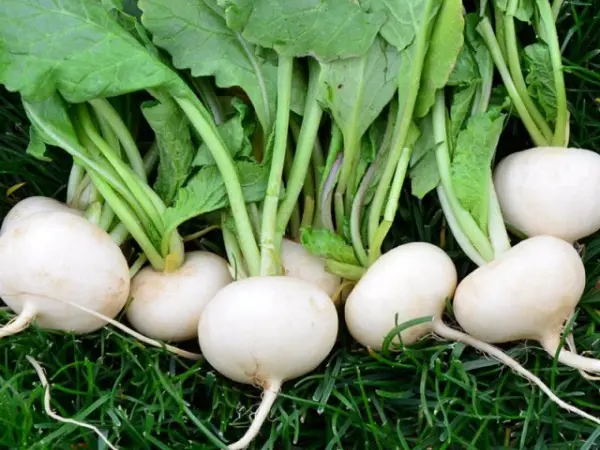
The mid-season fruit “Alba” is a Belarusian high-yielding variety weighing about 25 grams. In the process of ripening, it takes the form of an oval with an elongated tip, has a white color of the peel and pulp. The pulp is tender, juicy, sweet. The advantage of the variety is a long shelf life. In addition, Alba is resistant to shooting.
Variety “Ice icicle”. The only difference from the usual pink-red radish is a longer ripening period (may exceed 40 days) and a high percentage of quality harvest. The pulp is juicy, medium-sharp, crispy. “Ice icicle” can be stored for a long time without losing taste and aesthetic appearance. The vegetable reaches 15 centimeters in length, suitable for any type of soil.
Radish “White Fang”. The shape of the radish is conical, the tip is elongated, the peel is white, smooth. Weight 24 grams, fruit length 3,5 centimeters. The pulp is tender, juicy, slightly bitter, slightly spicy taste. It is recommended to grow “White Fang” only in open ground.
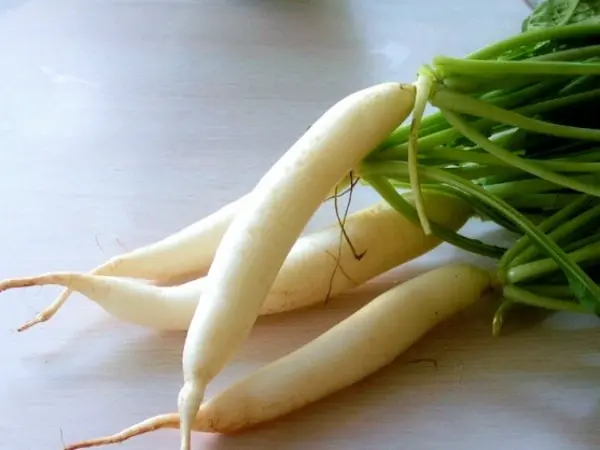
Variety “Virovsky white” is intended only for open soil. Mid-season radish with a high percentage of quality yield. Shooting resistant. The shape of the root crop is round (sometimes flat, the tip is almost invisible), large (about 4 centimeters in diameter). The pulp is tender, juicy, with a pleasant sweet aftertaste.
Among the less common varieties, I would like to note the watermelon radish, which is a culinary trend in California. From the outside, the vegetable seems to be an unsightly, familiar product. The root is white on the outside and pinkish red on the inside. Also inside are pink and white streaks. The length of the fetus is 8 centimeters. The shape resembles a small radish. Watermelon radish has a neutral taste, but looks spectacular in salads and main dishes, as it really looks like a watermelon. The taste of the fruit is uneven: the edges are bitter, the middle is sweet.
This vegetable can be consumed raw (it is recommended to separate the pulp from the peel), as well as thermally processed. It is customary to add it to side dishes or salads. Radishes go well with poultry and fish. The benefit of the vegetable lies in the high concentration of folic acid and vitamin C. You can buy watermelon radish seeds in online stores or specialized markets.
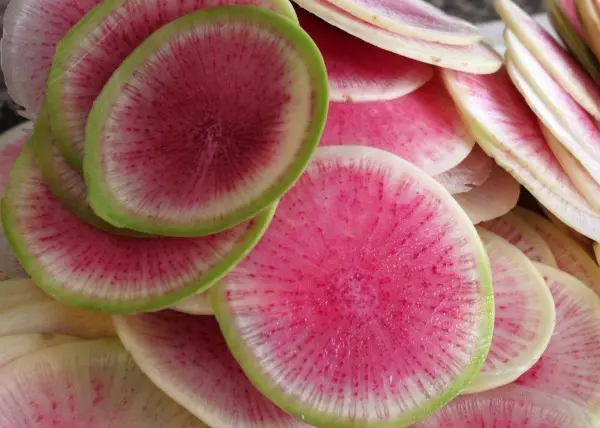
Another white root vegetable is daikon, which is very popular in Asian cuisine. The acceptable name of the vegetable is “Japanese” or “Chinese radish”, “sweet radish”. It is also called “white radish”. The most commonly used varieties of daikon are Nerrima, Shagoni, Shiroagari, Miyagase.
The shape of the daikon depends on the variety of seeds. The fruit is able to take on a conical, cylindrical, more square or rounded shape. The length of the root crop can reach 40 centimeters and weigh about 5 kilograms. The leaves of the plant are long, dissected. The peel is soft, thin, loose, white.
The amount of mustard oil in daikon is minimal, therefore, it does not taste bitter, but has a delicate sweetish taste. Eating a Chinese vegetable is recommended for people with pathologies of the gastrointestinal tract, cardiovascular system, and diabetes. Daikon removes fluid accumulations, cleanses the liver and kidneys, enriches the body with carotene, magnesium, ascorbic acid, and is a source of fiber. The vegetable has specific storage conditions – root crops must be kept in a cellar or other room with minimal access to sunlight.
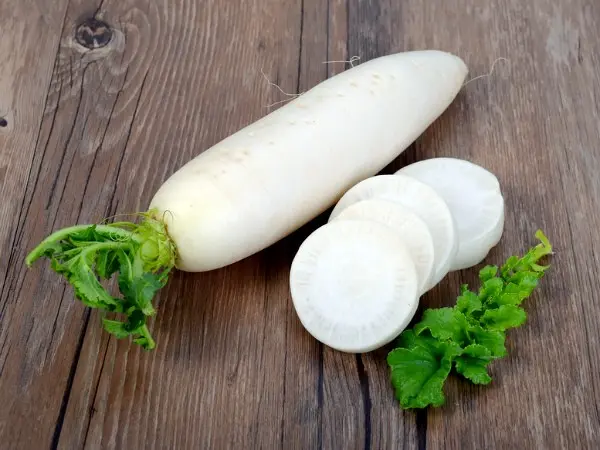
Features of landing
In white root crops (except for daikon and “Ice Icicle”), the growing season is minimized, which increases the number of crops per season.
You need to know a few features of planting radishes:
- fertile soil (when preparing the soil, it should be enriched with organic matter and mineral fertilizers;
- location for the beds – an open place with a sufficient amount of sunlight;
- the optimal height of the beds is 15 centimeters;
- seed planting depth – 2 centimeters.
Care
When growing root crops in a greenhouse, it is necessary to regulate the lighting. You can cover the pre-prepared frame with a black film and use it depending on the length of daylight hours.
Remember that with an increase in daylight hours, root crops throw out a flower arrow, and this is fraught with a deterioration in taste characteristics, quality and quantity of the crop.
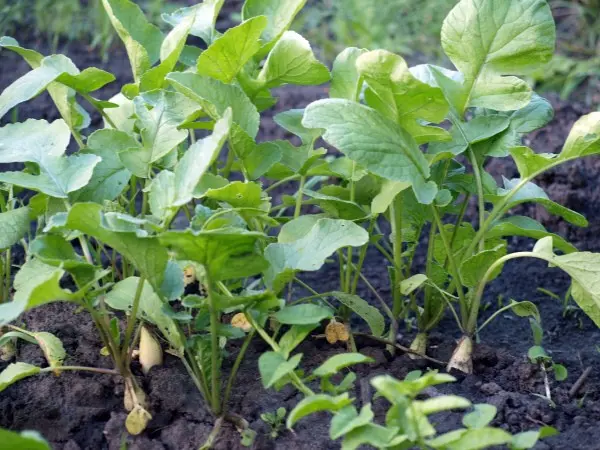
It is important to monitor soil moisture. With insufficient water, the root crop becomes bitter, becomes hard or hollow, the plant quickly shoots. An excess of moisture provokes cracking inside the vegetable.
Among the pests of radishes, the main one is the cruciferous flea, which eats leaves and especially threatens seedlings. Since it is undesirable to use chemicals for early varieties, use folk remedies for the parasite (for example, tobacco dust, ash, garlic infusion).
Not all varieties of radishes are resistant to adverse environmental conditions. To avoid problems, choose hybrids that are resistant to diseases and pests.
Observe crop rotation. Vegetables that can prepare a bed for further planting radishes: potatoes, cucumbers, tomatoes, legumes. Forbidden precursor vegetables: radish, cabbage, turnip.
Video “Radish Varieties”
Look at the review of the best varieties of radish from the Poisk agricultural company. Among them you will find white root vegetables.










